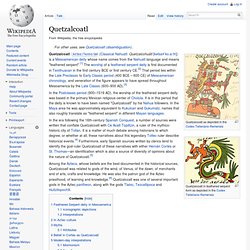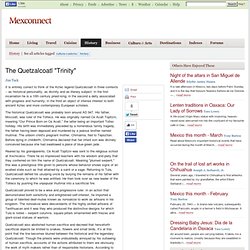

Quetzalcoatl. Quetzalcoatl /ˌkɛtsɑːlˈkoʊɑːtəl/ (Classical Nahuatl: Quetzalcohuātl [ketsaɬˈko.aːtɬ]) is a Mesoamerican deity whose name comes from the Nahuatl language and means "feathered serpent".[1] The worship of a feathered serpent deity is first documented in Teotihuacan in the first century BCE or first century CE.[2] That period lies within the Late Preclassic to Early Classic period (400 BCE – 600 CE) of Mesoamerican chronology, and veneration of the figure appears to have spread throughout Mesoamerica by the Late Classic (600–900 AD).[3] In the era following the 16th-century Spanish Conquest, a number of sources were written that conflate Quetzalcoatl with Ce Acatl Topiltzin, a ruler of the mythico-historic city of Tollan.

Feathered Serpent deity in Mesoamerica[edit] A feathered serpent deity has been worshiped by many different ethno-political groups in Mesoamerican history. Iconographic depictions[edit] The Quetzalcoatl "Trinity" Jim Tuck It is entirely correct to think of the Aztec legend Quetzalcoatl in three contexts -- as historical personality, as divinity and as literary subject.

In the first incarnation he is a 10th century priest-king; in the second a deity associated with progress and humanity; in the third an object of intense interest to both ancient Aztec and more contemporary European scholars. Topiltzin Ce Acatl Quetzalcoatl. Cē Ācatl Topiltzin[pronunciation?]

(Our Prince One-Reed Feathered Serpent) is a mythologised figure appearing in 16th-century accounts of Nahua historical traditions, where he is identified as a ruler in the 10th century of the Toltecs—by Aztec tradition their predecessors who had political control of the Valley of Mexico and surrounding region several centuries before the Aztecs themselves arrived on the scene. In later generations, he was a figure of legend often confused or conflated with the important Mesoamerican deity Quetzalcoatl. One estimate puts the years of his reign from 923 to 947, although the correlation between dates of Toltec history and the Gregorian calendar remain uncertain, as does the very nature of a defined "Toltec civilization" itself.